Product recommendations aren’t new. Remember the times when physical stores used human-led personal recommendations? Yes, they existed even before the internet. Personalized product recommendations try to replicate this for online stores at scale.
However, many online sites don’t have an organized system to suggest multiple products. What if we tell you 91% of customers would abandon an online retailer over a poor shopping experience? That’s right. With changes in digital and web experiences, customers need a personalized shopping experience to influence their buying decisions.
A report from McKinsey says that Product recommendations can increase revenue by 300%. There’s a lot of potential sales to be won by adding personalized product recommendations to your online ecommerce stores.
What are product recommendations?
Product recommendations are select products users see across multiple pages on a site. These are algorithm-based relevant recommendations to craft a personalized shopping experience to influence purchasing. How? These product recommendations are powered by artificial intelligence and algorithms to predict and suggest products that will interest customers.
But creating a powerful shopping journey starts after deploying the AI that tracks data—shopper’s behavior, browsing habits, and situational context.
Benefits of Product Recommendations for Scaling Ecommerce Businesses
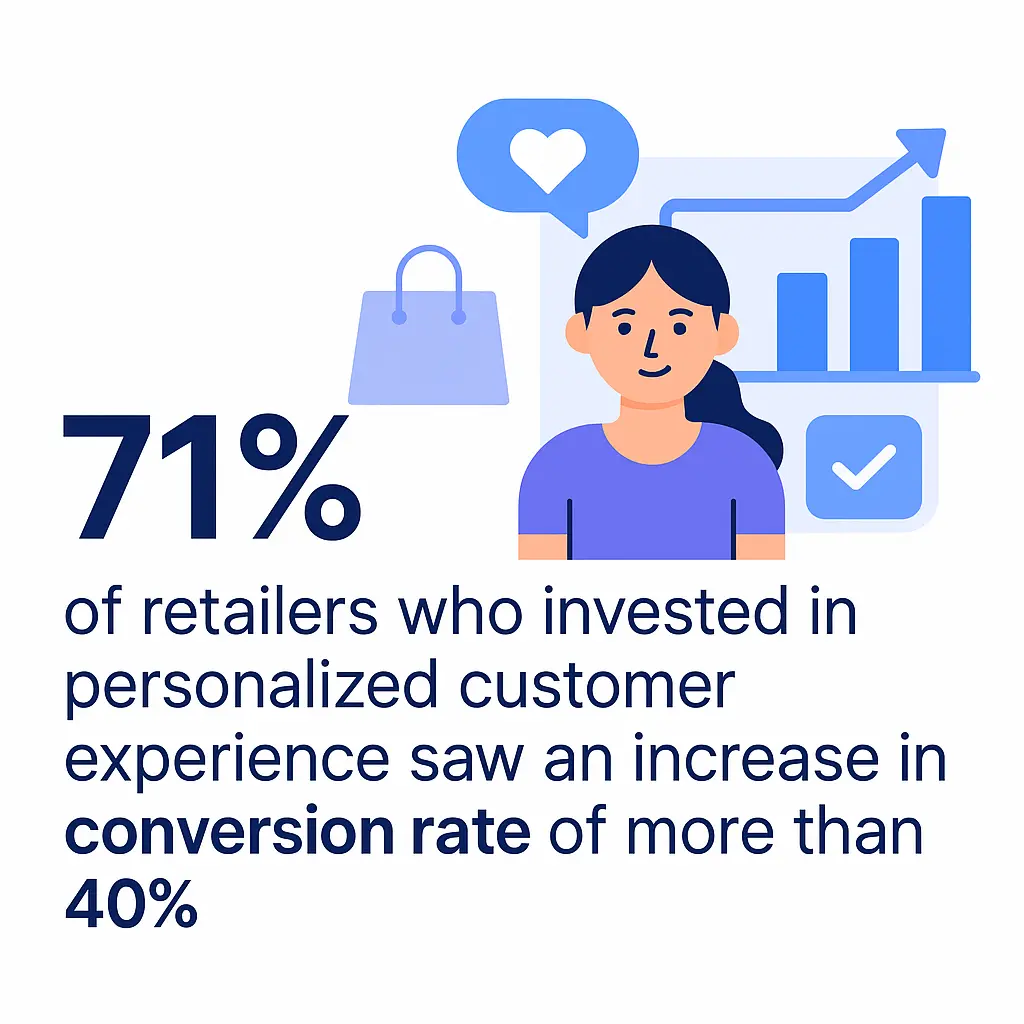
When ecommerce stores leverage personalized product recommendations, they are likely to see this spike in conversions. Here’s why.
Product discovery
There are thousands and thousands of products on your web store, which means customers will not find relevant products. Moreover, shoppers won’t know exactly which products from your offerings match their preferences. By suggesting products that match the shopper’s preferences, they will discover more products that fit their interest, and at the same time, they can quickly navigate through the store without being distracted by multiple products in the store.
Good customer experience
Think about when a customer decided to leave the website because they couldn’t find the right product, but a product recommendation influenced their decision. By recommending relevant products to your customers, you show them the products they are genuinely interested in, simplify their buying decisions and deliver a seamless shopping experience.
Boosts purchases
In online shopping, relevance equals conversion. When customers see a relevant product from the product recommendation widget, they click and purchase it. By showcasing exactly what the shopper wants, you retain the sales.
Types of product recommendations
Before jumping into product recommendation examples, let’s understand the different types of product recommendations and how AI helps shoppers by recommending products:
- Collaborative filtering: It segments customers into groups based on their actions—similar purchasing or browsing patterns. The AI then analyzes the behavior of previous buyers and suggests products to the shoppers who have not completed the desired action. Usually, this includes a series of actions.
For example, if certain customers have clicked on products A, B, and C and another shopper clicks on products A and B, they will see product recommendations for C.
- Content-based filtering: Uses shoppers’ patterns like their profile and previous purchase history to recommend similar products matching their interests.
- Hybrid recommender system: This is a combination of collaborative and content-based filtering. Both the filters are run separately and combined to find the products the shopper really wants to buy.
Product Recommendation Examples 2025
1. Bestseller and trending products
With the bestselling and trending product recommendations on the homepage, people can see what other customers have purchased.
- Bestselling product recommendations: These products are the most sold products on your ecommerce website. These, too can be changed for different users based on their preferences.
- Trending product recommendations: These products suggest recent trends like seasonal and festive trends to convince the shoppers to check them out.
Sephora–best-selling and trending product recommendation
Here’s how Sephora welcomes its new visitors by placing its bestselling products on the homepage:
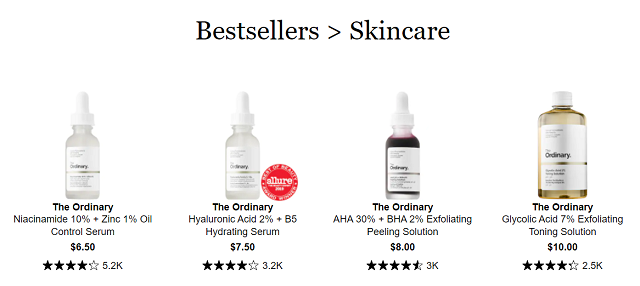
And here are trending products.

Why it works?
These product recommendations guide the visitors to learn more about the most popular and trending products in your store that are likely to drive more conversions.
2. New arrivals on the home page
With the new arrivals widget, new products are added to the inventory.
Reebok–New arrivals
Look how Reebok leverages the New Arrivals widget to let the customers know about the fresh designs.
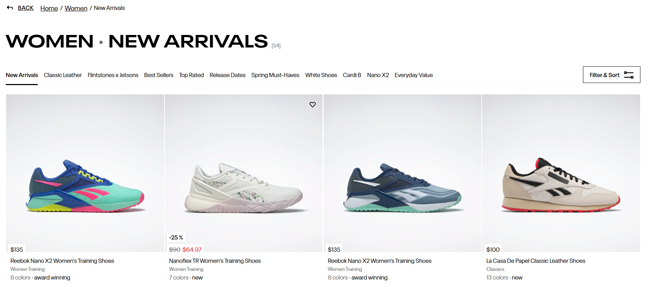
Why it works?
The homepage is the primary touchpoint for visitors to the ecommerce store. Adding the New Arrivals widget creates a buzz among the shoppers about the new product launches.
3. Recommendations to cross-sell products
Cross-selling is an excellent way to leverage ecommerce sales and boost customer satisfaction by recommending products that accentuate the one being purchased. Add the ‘Works Well With’ or ‘Goes With This’ widget on the product page to optimize your product recommendation strategy.
MAC–Cross-sell product recommendation
MAC offers relevant products that complement the lipstick the shopper is viewing.
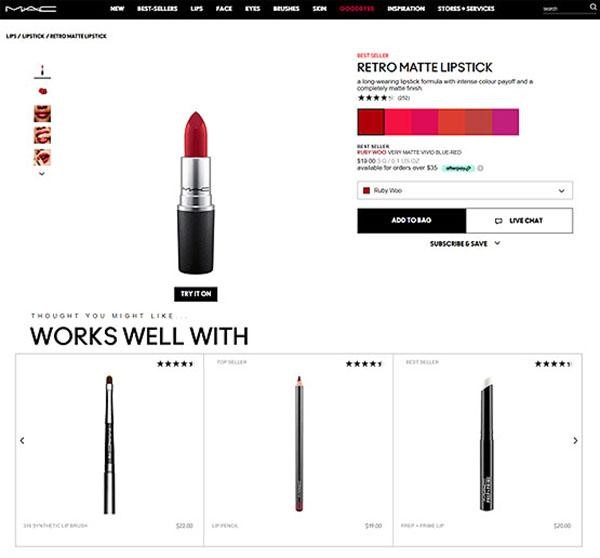
Why it works?
When the shopper is offered relevant products that complement the MAC lipstick they viewed, they can add products that match their preference into the cart and increase the order value.
4. Product recommendations with personalized search results
Intelligent search results are necessary for maintaining the engagement levels of visitors. To produce personalized search results, the AI collects data from various aspects of a shopper’s patterns and also from the search terms the shopper uses.
Forever 21–Personalized search results
Let us look at this search personalization example by Forever 21.
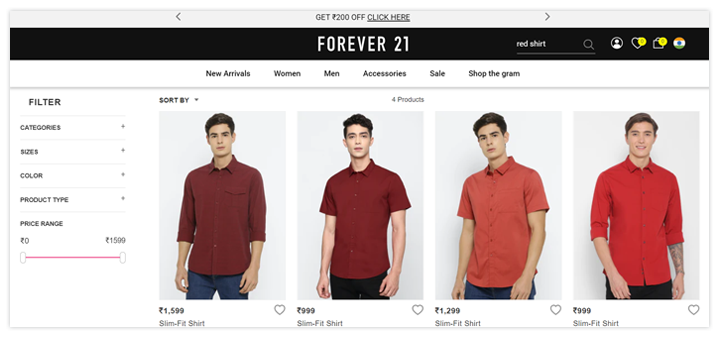
Why it works?
When a shopper searches for ‘red shirt’, the website will display red shirts for men. Why? Because the website has identified data about the shopper’s gender, which helps show more relevant search results.
5. Product recommendations based on behavior
When the website analyzes a shopper’s behavior like their browsing, searching, and buying patterns, AI sends out personalized production recommendations.
- Customer also viewed: The ‘Customer Also Viewed’ widget displays the most explored products by the customers.
- Recommended for you: The ‘Recommended For You’ widget suggests products after predicting a shopper’s recent search and purchase pattern.
McDonald’s–Behavior-based product recommendation
Below is an example of how McDonald’s recommends different burger options for the customer who frequently orders a single burger patty.
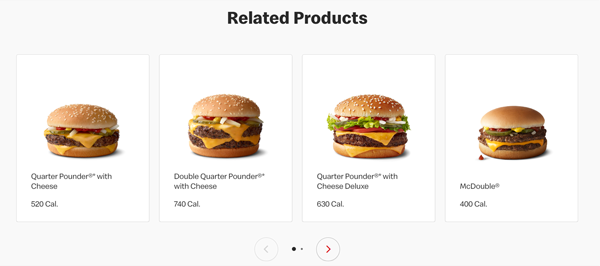
Why it works?
Since the customer’s purchase history includes single patty burgers, the AI analyzed the customer’s patterns and suggested more varieties of burgers in the higher price range with better offers.
6. Similar product recommendations
Displaying similar product recommendations suggests products based on the brands, product category, and other attributes they are currently browsing.
Shoppers will see a ‘Similar Products’ or ‘You May Also Like’ widget catalog below the products they view.
Walmart–Similar products recommendation
See how Walmart recommends similar products to the one being viewed.
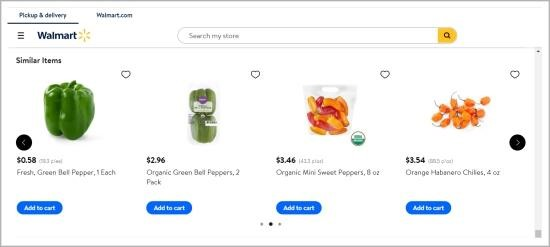
Why it works?
When visitors are not satisfied with currently viewed products, they can explore similar products to find better preferences. For example, at Walmart, a visitor looks for a certain vegetable but couldn’t find a relevant match. With the Similar Products widget, they can discover more items and find the one that may better suit their preference.
7. Recommendations before exit
This is a last-minute approach to tempt the shoppers who decide to leave the website.
If the visitor is going to exit the website, Martech platforms are powered to display a pop-up with a list of products to tempt them.
Once Upon a Trunk–Exit intent product recommendation
Take a look at this exit-intent product recommendation by Once Upon a Trunk.

Netcore added the exit-intent popup to the brand’s website, which alone contributed to 0.6% of their revenue leading to increased conversion.
Why it works?
This entices hesitant shoppers to explore the undiscovered products. Giving a discount before they exit is also a great way to retain shoppers who were price sensitive.
8. Product recommendations on email
Send product recommendations on email to nurture your customers and drive them to your website. Instead of sending bulk recommendations, study the customer’s behavior and send them personalized product recommendations.
Croc’s India–Personalised email recommendations
Here’s how Crocs India sends its customers a personalized email product recommendation.
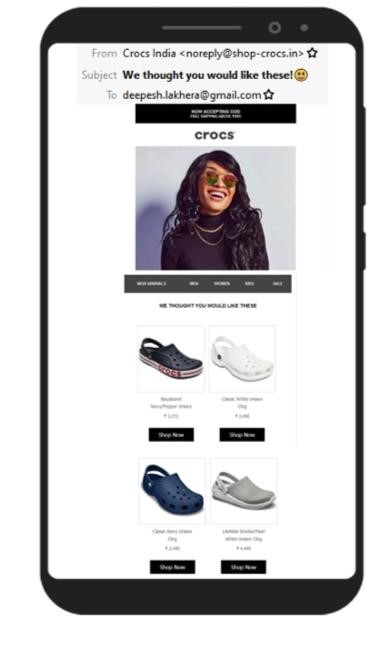
Netcore helped Crocs India personalize their email journey leading to a 42X higher ROI. By using Netcore, they were able to send personalized emails based on their history and customer behavior. This reduced cart abandonment, reactivated these customers, and upsold products.
Why it works?
By sending a personalized product recommendation email, you can retarget inactive buyers and reduce cart abandonments.
Here are some other ways to use email product recommendations:
- Send ‘We Miss You’ email if the customer hasn’t visited your website in the past one month and reactivate the dormant shoppers.
- Send email reminders to customers who have abandoned the cart. In your email, you can also recommend new products to customers.
9. Curated page tailored to preferences
Showcase the range of products that are based on your customers’ shopping habits with a curated boutique page. This page is made by taking explicit feedback from the visitors—likes/dislikes. Based on this observation, a curated boutique page is made.
Zivame–Personalized boutique page
Below is an example by Zivame. They have curated a boutique page for their customers based on their recent activity in the store.
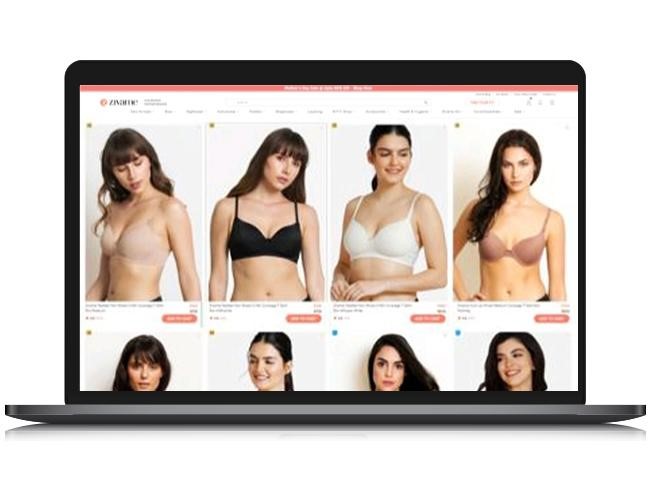
Using this product recommendation strategy, Netcore helped Zivame to generate 12X the marketing ROI.
On deploying Netcore, the AI analyzed Zivame’s customers’ buying patterns and curated a boutique page for them.
Why it works?
AI studies the shoppers’ explicit preferences, the brands they like, the type of products they are looking for, and the price range. Based on this information, it curates a page relevant to customer’s needs which helps in making an informed decision.
How AI & Machine Learning Simplify Product Discovery at Scale
As ecommerce businesses grow and expand their product catalogs, helping customers find the right products quickly becomes a serious challenge. That’s where AI and machine learning come in.
56% of retailers say real-time behavioral data will be a major focus in the years ahead—and for good reason.
Netcore’s Personalization Platform empowers ecommerce brands to deliver exactly that: a seamless shopping experience where each customer is shown products that match their behavior, preferences, and intent, in real time.
Retailers are shifting away from one-size-fits-all merchandising and moving toward hyper-personalized experiences. That means using customer data and AI to tailor everything, from recommendations and content to messages uniquely for each shopper.
This evolution isn’t just about tech, it’s about growth. Personalization drives higher conversion rates, larger order values, and stronger customer loyalty. With rising customer expectations and smarter tools, personalized experiences are no longer optional, they’re essential for success in modern ecommerce.
How Netflix-Style Personalization Can Revolutionize Product Recommendations in Ecommerce
According to Business Insider, a staggering 75% of what people watch on Netflix comes from its personalized recommendations. That’s the power of using behavioral data to anticipate what users want, driving stickiness, engagement, and satisfaction.
Now, imagine applying the same intelligence to your ecommerce store.
Just like Netflix analyzes what you watch, how often you engage, and how long you stay, ecommerce brands can leverage real-time user behavior, such as browsing patterns, click frequency, and time spent on product pages, to recommend exactly what shoppers are most likely to buy.
Netflix doesn’t show every user the same homepage, and your ecommerce platform shouldn’t either. By adopting this approach, you transform product discovery into a tailored experience that keeps customers coming back.
Check out the Netcore Playbook to learn how product recommendations can turn browsers into buyers.
Top 3 Product Recommendation Platforms for E-commerce
Choosing the right product recommendation engine is critical for scaling ecommerce growth. Here are the top 3 platforms:
1. Netcore
Purpose-built for ecommerce, Netcore offers real-time, AI-powered product recommendations based on live user behavior, Affinity segments, and preferred channels (like WhatsApp, Push, and Email). Brands love its ease of implementation, transparent algorithms, and measurable ROI. Results include 3X higher conversions and up to 28% lift in AOV.
Bonus: Seamless catalog integration and suppression of irrelevant/out-of-stock products.
2. Algolia Recommend
Excellent for search-driven discovery with blazing-fast performance. It’s developer-friendly and customizable but lacks out-of-the-box, cross-channel personalization and affinity tracking for full-funnel journeys.
3. Dynamic Yield
Known for its robust testing and personalization capabilities, Dynamic Yield is a strong contender for enterprises. However, it often requires more technical effort to customize and doesn’t offer as much transparency in how recommendations are generated.
Must-Have Features in an Enterprise-Ready Product Recommendation Platform
For fast-growing ecommerce brands, choosing the right product recommendation engine isn’t just about features; it’s about performance, efficiency, and revenue impact.
Here’s what senior marketers should evaluate:
- Scalability: Can the platform handle millions of users and SKUs in real-time, without performance drops during peak sales?
- Omnichannel Personalization: Customers bounce across web, app, email, SMS, WhatsApp, and push. Your recommendations should follow the context.
- Preferred Channel Optimization: You’re spending lakhs monthly on communications, email, SMS, WhatsApp, and app notifications. But what if you only paid for messages that mattered? Netcore’s Preferred Channel feature identifies the one channel each user is most likely to engage with, saving wasted spend and improving engagement. Combine that with personalized product recommendations, and brands have seen a 25–30% lift in conversions and 3X ROI just by optimizing communication.
- Ease of Integration: Your platform should plug into your ecommerce ecosystem quickly, with prebuilt connectors, real-time catalog sync, and minimal dev effort.
- Transparent AI & CSM Support: Customizable algorithms, no black-box logic, and dedicated customer success support are table stakes for enterprise.
Bottom line: If you want to scale smarter, not noisier—Netcore delivers the personalization, intelligence, and ROI modern ecommerce demands.
Why Leading Ecommerce Brands Choose Netcore for Product Recommendations
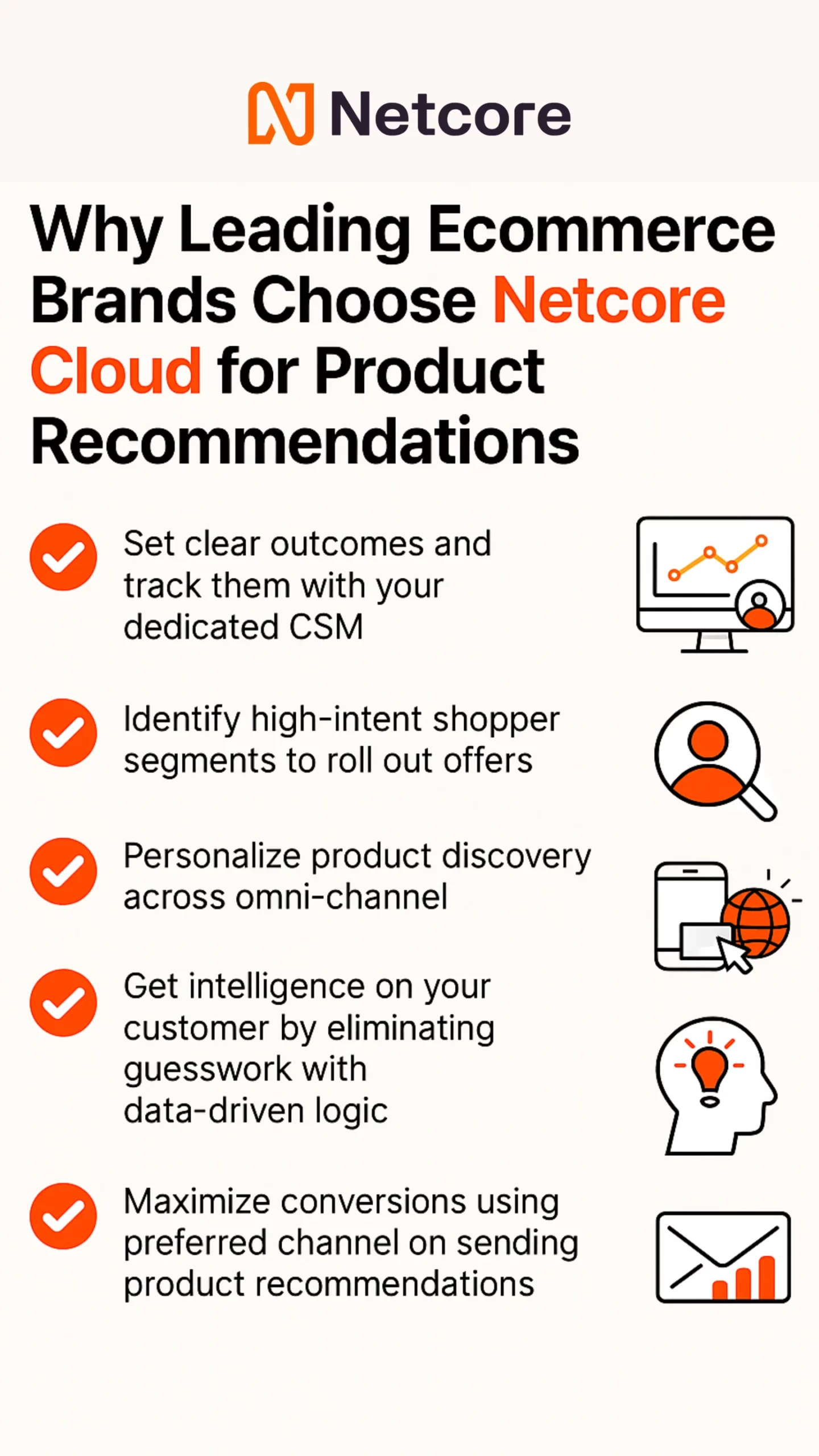
See How Netcore Transformed Product Discovery for a Leading Ecommerce Brand
A major ecommerce brand was struggling, conversion rates were stuck at just 5%, and bounce rates had surged to 78%. Product discovery was failing to deliver.
After implementing Netcore’s personalized product recommendations, 32% of total revenue is now driven by intelligent, real-time recommendations, turning passive browsers into active buyers. Find out how.
Get Custom Product Recommendation Strategy for Your Ecommerce Business
Whether you’re struggling with low click-throughs, high cart abandonment, or irrelevant suggestions, our team is here to help you fix that fast. Our experts will analyze your current performance, map out opportunities, and build a strategy designed to deliver measurable ROI. We’ll also show you how to execute with Netcore’s full-stack personalization engine, without needing a full tech team. Book Custom Strategy Consultation today.
 Holiday Sales Are Won Now — Grab the 2025 Holiday Marketing Guide to Unlock More Revenue.
Holiday Sales Are Won Now — Grab the 2025 Holiday Marketing Guide to Unlock More Revenue. 









